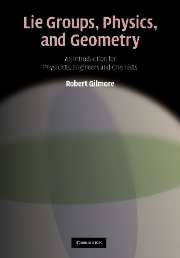Book contents
- Frontmatter
- Contents
- Preface
- 1 Introduction
- 2 Lie groups
- 3 Matrix groups
- 4 Lie algebras
- 5 Matrix algebras
- 6 Operator algebras
- 7 EXPonentiation
- 8 Structure theory for Lie algebras
- 9 Structure theory for simple Lie algebras
- 10 Root spaces and Dynkin diagrams
- 11 Real forms
- 12 Riemannian symmetric spaces
- 13 Contraction
- 14 Hydrogenic atoms
- 15 Maxwell's equations
- 16 Lie groups and differential equations
- Bibliography
- Index
4 - Lie algebras
Published online by Cambridge University Press: 05 September 2012
- Frontmatter
- Contents
- Preface
- 1 Introduction
- 2 Lie groups
- 3 Matrix groups
- 4 Lie algebras
- 5 Matrix algebras
- 6 Operator algebras
- 7 EXPonentiation
- 8 Structure theory for Lie algebras
- 9 Structure theory for simple Lie algebras
- 10 Root spaces and Dynkin diagrams
- 11 Real forms
- 12 Riemannian symmetric spaces
- 13 Contraction
- 14 Hydrogenic atoms
- 15 Maxwell's equations
- 16 Lie groups and differential equations
- Bibliography
- Index
Summary
The study of Lie groups can be greatly facilitated by linearizing the group in the neighborhood of its identity. This results in a structure called a Lie algebra. The Lie algebra retains most, but not quite all, of the properties of the original Lie group. Moreover, most of the Lie group properties can be recovered by the inverse of the linearization operation, carried out by the EXPonential mapping. Since the Lie algebra is a linear vector space, it can be studied using all the standard tools available for linear vector spaces. In particular, we can define convenient inner products and make standard choices of basis vectors. The properties of a Lie algebra in the neighborhood of the origin are identified with the properties of the original Lie group in the neighborhood of the identity. These structures, such as inner product and volume element, are extended over the entire group manifold using the group multiplication operation.
Why bother?
Two Lie groups are isomorphic if:
(i) their underlying manifolds are topologically equivalent;
(ii) the functions defining the group composition laws are equivalent.
Two manifolds are topologically equivalent if they can be smoothly deformed into each other. This requires that all their topological indices, such as dimension, Betti numbers, connectivity properties, etc., are equal.
Two group composition laws are equivalent if there is a smooth change of variables that deforms one function into the other.
- Type
- Chapter
- Information
- Lie Groups, Physics, and GeometryAn Introduction for Physicists, Engineers and Chemists, pp. 55 - 73Publisher: Cambridge University PressPrint publication year: 2008



